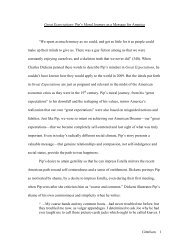Dombey and Son - 2002 (PDF) - The Dickens Project
Dombey and Son - 2002 (PDF) - The Dickens Project
Dombey and Son - 2002 (PDF) - The Dickens Project
Create successful ePaper yourself
Turn your PDF publications into a flip-book with our unique Google optimized e-Paper software.
ibliography<br />
notes to chapters one through three for additional important biographical sources by Henry <strong>Dickens</strong>, Mamie<br />
<strong>Dickens</strong>, Aylmer, Kent, Nisbet, Rose, Slater, Storey, Tomalin, <strong>and</strong> Welsh, among others). Useful shorter<br />
biographies that were able to draw upon Walter Dexterís three-volume collection of letters for the Nonesuch<br />
Edition are Una Pope-Hennessy, Charles <strong>Dickens</strong>: 1812-1870 (London: Chatto <strong>and</strong> Windus, 1946) <strong>and</strong> Hesketh<br />
Pearson, <strong>Dickens</strong>: His Character, Comedy, <strong>and</strong> Career(London: Methuen, 1949). J. B. Priestleyís Charles<br />
<strong>Dickens</strong>: A Pictorial Biography (London; Thames <strong>and</strong> Hudson, 1961) has excellent illustrations, as do Angus<br />
Wilsonís <strong>The</strong> World of Charles <strong>Dickens</strong>(New York: <strong>The</strong> Viking Press, 1970), which is equally notable for its<br />
sound text, written by a major novelist who well underst<strong>and</strong>s that <strong>Dickens</strong>ís development did not end at<br />
Warrenís. Other centenary volumes notable for illustrative materials are Charles <strong>Dickens</strong>, 1812-1870: An<br />
Anthology Chosen <strong>and</strong> Annotated by Lola L. Szladits from Materials In <strong>The</strong> Berg Collection(New York: New York<br />
Public Library, 1970), Charles <strong>Dickens</strong>: An Exhibition to Commemorate the Centenary of His Death, June-<br />
September 1970(London: Victoria <strong>and</strong> Albert Museum, 1970), <strong>and</strong> E. W. F. Tomlin, ed. Charles <strong>Dickens</strong> 1812-<br />
1870: A Centenary Volume (London: Weidenfeld & Nicolson, 1969). More recent biographies of note include<br />
Fred Kaplanís extremely professional <strong>Dickens</strong>: A Biography (New York: Morrow, 1988) <strong>and</strong> Peter Ackroydís<br />
immense<strong>and</strong> highly idiosyncratic <strong>Dickens</strong> (London: Sinclair-Stevenson, 1990), which, like Wilsonís, gains insight<br />
from having been written by a practicing novelist.<br />
<strong>Dickens</strong>ís childhood has naturally attracted specialized biographies. <strong>The</strong> first of these is Robert Langtonís <strong>The</strong><br />
Childhood <strong>and</strong> Youth Of Charles <strong>Dickens</strong> (London: Hutchinson & Company, 1891), which adds a good deal to<br />
what Forster knew; the most recent <strong>and</strong> authoritative, if dry, is Michael Allen, Charles <strong>Dickens</strong>í Childhood<br />
(Basingstoke: Macmillan, 1988), which corrects <strong>and</strong> adds to Johnsonís account; in between is the very readable<br />
<strong>and</strong> intelligent Christopher Hibbert, <strong>The</strong> Making of Charles <strong>Dickens</strong> (New York, Harper & Row, 1967). Albert<br />
D. Hutter, "Reconstructive Autobiography: the Experience at Warrenís Blacking," <strong>Dickens</strong> Studies Annual 6<br />
(1977), 1-14 is an important psychoanalytic study that deserves to be read alongside Steven Marcusís essay<br />
"Who is Fagin?" discussed in chapter two. Peter Rowl<strong>and</strong> has compiled an interesting <strong>and</strong> entertaining<br />
autobiographical collage as My Early Times (London: Aurum Press, 1997). Although necessarily synthetic <strong>and</strong><br />
in some degree fanciful, it is also scholarly, being scrupulous in identifying its components, which are drawn<br />
from all <strong>Dickens</strong>ís writing, including of course the autobiographical fragment.<br />
<strong>Dickens</strong>ís celebrity in his lifetime insured that there would be a great many published recollections. Philip<br />
Collins has gathered the best of these in <strong>Dickens</strong>: Interviews <strong>and</strong> Recollections, 2 vols. (London: Macmillan,<br />
1981). For <strong>Dickens</strong> in his last years, George Dolby, Charles <strong>Dickens</strong> As I Knew Him (London, T. Fisher Unwin,<br />
1912), is worth reading in spite of its four-hundred-plus pages. (Dolby was <strong>Dickens</strong>ís manager for the reading<br />
tours after 1866.)<br />
Historical <strong>and</strong> Background Studies, Literary History<br />
Excellent general background studies of the Victorians especially useful to students of <strong>Dickens</strong> are J. B.<br />
Schneewind, Backgrounds of English Victorian Literature (New York: R<strong>and</strong>om House, 1970); Richard D. Altick,<br />
Victorian People <strong>and</strong> Ideas (New York: W. W. Norton & Company, 1973); <strong>and</strong> Robin Gilmour, <strong>The</strong> Victorian<br />
Period: <strong>The</strong> Intellectual <strong>and</strong> Cultural Context of English Literature, 1830-1890, Longman Literature in English<br />
Series (London: Longman, 1993). Humphry House, <strong>The</strong> <strong>Dickens</strong> World (Oxford: Oxford University Press, 1941)<br />
inaugurated modern historical scholarship on <strong>Dickens</strong>. Houseís account of the political, religious, <strong>and</strong> more<br />
general intellectual ethos in which <strong>Dickens</strong> wrote becomes more valuable with every year that carries us further<br />
from the Victorians. John Butt <strong>and</strong> Kathleen Tillotson in <strong>Dickens</strong> at Work (London: Methuen, 1957) study<br />
topical influences <strong>and</strong> demonstrate how deeply involved <strong>Dickens</strong> wasóhis apparently universal appeal<br />
notwithst<strong>and</strong>ingóin contemporary <strong>and</strong> local issues. (Tillotsonís "Introductory" chapter <strong>and</strong> her chapter on<br />
<strong>Dombey</strong> <strong>and</strong> <strong>Son</strong> in her Novels of the Eighteen-Forties[Oxford: Clarendon, 1954] show also how mutually<br />
influential were <strong>Dickens</strong>, Charlotte Brontë, Thackeray, <strong>and</strong> Gaskell.) Philip Collins, <strong>Dickens</strong> <strong>and</strong> Crime<br />
(London: St. Martinís, 1962) <strong>and</strong> <strong>Dickens</strong> <strong>and</strong> Education (London: Macmillan, 1963) study subjects of great<br />
importance for <strong>Dickens</strong> <strong>and</strong> are worthy successors to House. So too is Norris Popeís <strong>Dickens</strong> <strong>and</strong> Charity(New<br />
York: Columbia University Press, 1978), which provides along the way a better account of <strong>Dickens</strong> <strong>and</strong> religion<br />
than do many more precisely focused studiesóas for that matter does Alex<strong>and</strong>er Welsh, <strong>The</strong> City of <strong>Dickens</strong><br />
(Oxford: Clarendon, 1971), which is as much about the heavenly city as the secular. Fred Kaplan, Sacred Tears:<br />
http://dickens.ucsc.edu/bibliographies/dombeybiblio/DS_Biblio.html[11/22/11 10:42:15 AM]



